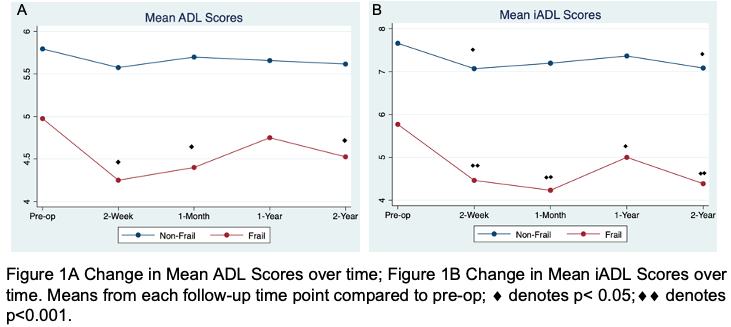Impact Of Frailty On Long-Term Functional Decline Following Vascular Surgery
Madeline DeAngelo, BS, Jordan Peacock, BS, Teryn A. Holeman, BS, MS, Maria Maloney, MPA, Julie Beckstrom, RN, MS, Brigitte K. Smith, MD, MHSE, Brigitte Smith, MD, MHPE, Benjamin S. Brooke, MD, PhD.
University of Utah School of Medicine, Salt Lake City, UT, USA.
OBJECTIVES: Frailty is a clinical syndrome associated with slow recovery after vascular surgery. However, the degree and length of functional impairment frail patients experience after surgery is unclear. The objective of this study was to prospectively measure changes in functional status among frail and non-frail patients undergoing vascular surgery procedures.
METHODS: Patients consented to undergo elective vascular surgery procedures at an academic medical center between May 2018 and March 2019 were prospectively identified. Prior to surgery, all patients underwent provider assessment of frailty using the validated Clinical Frailty Scale (CFS), as well as baseline assessment of functional status using the Katz Activities of Daily Living (ADL) index and the Lawton Instrumental Activities of Daily Living (iADL) index. These same instruments were used to evaluate each patientís functional status at 2-week, 1-month, 1-year, and 2-year time points following surgery. Changes in iADL and ADL scores among frail (CFS≥5) and non-frail patients were compared using paired Wilcoxon signed-rank tests and logistic regression models. RESULTS: A total of 126 patients were assessed before and after minor (55%) and major (45%) vascular procedures, of which 43 (34%) patients were determined to be frail prior to surgery. Frail patients were older and more likely than non-frail subjects to have medical comorbidities including chronic kidney disease, COPD, or diabetes (all p<0.05). When compared to the non-frail cohort, frail patients had significantly lower ADL and iADL scores before surgery and experienced a greater decline in ability to independently complete ADL and iADL activities after surgery that was sustained at 2-years (Figures 1A and 1B). After risk-adjustment, frailty was associated with an increased likelihood of decline in ADLs (OR:5.84;95%CI:2-17; P<.05) and iADLs (OR:6.6; 95%CI:3-16; P<0.001) at 2-years following surgery.
CONCLUSIONS: Frail patients experience a significantly greater decline in ability to perform ADL and iADLs than non-frail patients, that persists 2-years following vascular surgery. These data highlight the degree of functional decline occurring immediately following surgery, as well as risk for long-term, sustained impairment that should be shared with frail patients before undergoing a procedure. 
Back to 2022 Karmody Posters
